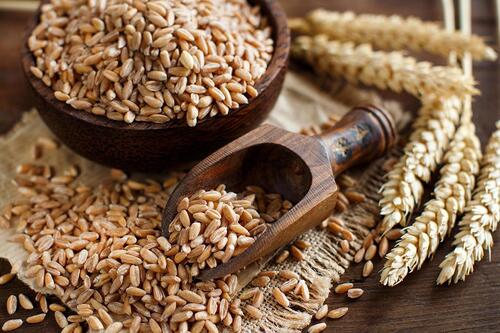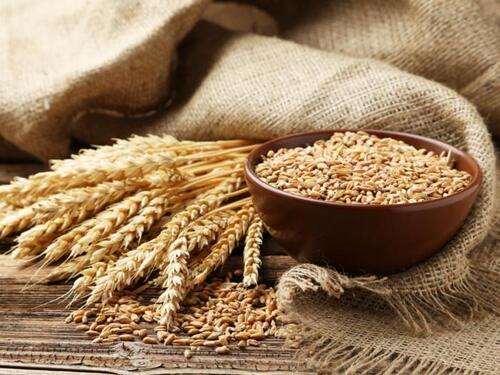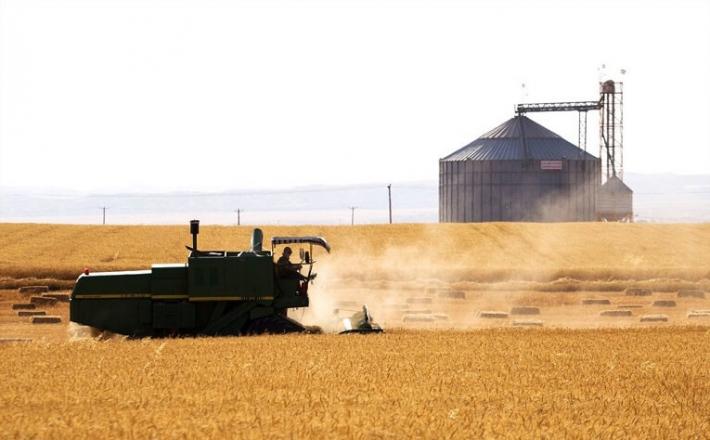Wheat is one of the most basic edible products not only in Kurdistan but also in the world. Wheat is one of those products that is consumed more than any other food product. Although this crop can grow in various kinds of temperatures in vast lands it also can be produced the best in the mild regions that have a 30 to 90 cm (12 to 36 inches) of rainfall annually.
Winter and spring wheat are the two main types of crop. The nutritional composition of wheat can vary with climate and soil differences. This crop contains 12 percent water, 70 percent carbohydrates, 12 percent protein, 2 percent fat, 1.8 percent mineral, and 2.2 percent fiber. It also contains thiamine, riboflavin, niacin, and a small amount of vitamin A.
Wheat is the most important crop that is produced in Kurdistan. The types of wheat grown in Kurdistan fields are diverse; the most important of which are Qandahari, Razaw, Bahara, Spika, and Zardka.
But when "Mexicobak" wheat was brought to Iraq in 1964, they began to cultivate it in 1967, and it was also cultivated widely in Kurdistan; particularly in those areas where the average amount of rainfall is between (450- 500) mm a year. Wheat cultivation occupies the largest agricultural area in the Kurdistan Region, but according to the condition of this area, it varies from year to year; the average amount of crops also varies from year to year due to climate changes.
This crop is consumed directly or indirectly as human and animal food, whether it is turned into flour and bread or used to make other kinds of food. Wheat flour is the main structure of most kinds of food. They include spaghetti, noodles, bread, …

The history of consuming wheat in Kurdistan
Farming and planting wheat has been a long-lasting Kurdish occupation and historical researchers show that before all other places, people living in the area today called Kurdistan were familiar with wheat and used it for their own food; as it is found in Charmo village near Chamchamal, Hazar Merdi near Suleimani and Ali Qush village in the East part of Kurdistan.
All historical evidence shows that civilization in Mesopotamia (the area between the two rivers) was based on crops, especially wheat. Later this product and how it is planted and produced had been transferred to other countries in Asia, Europe, and Africa. Therefore, it is believed that Kurdistan is considered to be the country where wheat was planted and cultivated for the first time.

The economic importance of wheat can be mentioned in these points:
Since wheat is considered to be a major product in human food, it has a high position in the economy of every country and it has been people's food source since prehistoric times. First, it was consumed while they used to roast it, and later they made it into flour and dough to make bread with it.
1. It is used in products like cakes, biscuits, and …
2. The stem and leaf while they are still green or dried are used as farm animals' food.
3. The parts of wheat that turn into hay are also used as animals' food.
4. The large sized wheat crops are used to make Sawar, and the milled wheat is used to make Harshta which are traditional Kurdish foods.
5. The most important use of wheat is to make bread with its flour.

Wheat production in Kurdistan Region Provinces
1. Hawler (Erbil) Province: This is the most important place in the Kurdistan Region for cultivating wheat. From 2010 to 2020 compared to other parts of Kurdistan, the largest amount of wheat belonged to this area. Undoubtedly it is because in this area a larger field is allocated to wheat cultivation, so this Province has allocated 1 million and 138 thousand and 437 acres of agricultural land for this product in the past 10 years.
2. Suleimani Province: This Province is in second place in cultivating wheat. The area that has been allocated to wheat cultivation is almost 320 thousand dunams. Its area is less than Hawler Province, but due to the soil quality of this Province compared to other Provinces in Kurdistan, it produces more wheat.
3. Duhok Province: It is the third Province in wheat production after Hawler and Suleimani, where 783,185 dunams of land have been allocated to wheat cultivation for 10 years.
4. Halabja Province: Wheat production continued from 2016 to 2020. The land of this Province was the most fertile and possessed the best quality and the best kind of wheat in the Kurdistan Region belonged to this Province. An area of 69 thousand and 39 dunams of this Province's land is occupied for wheat cultivation.
Now, it is time to harvest wheat in Kurdistan and based on the Ministry of Agriculture statistics, wheat production in Kurdistan has increased year after year both the amount of production and the variety of it. This year this amount reached 126 thousand tons which is less than twice the local needs of the Kurdistan Region.









